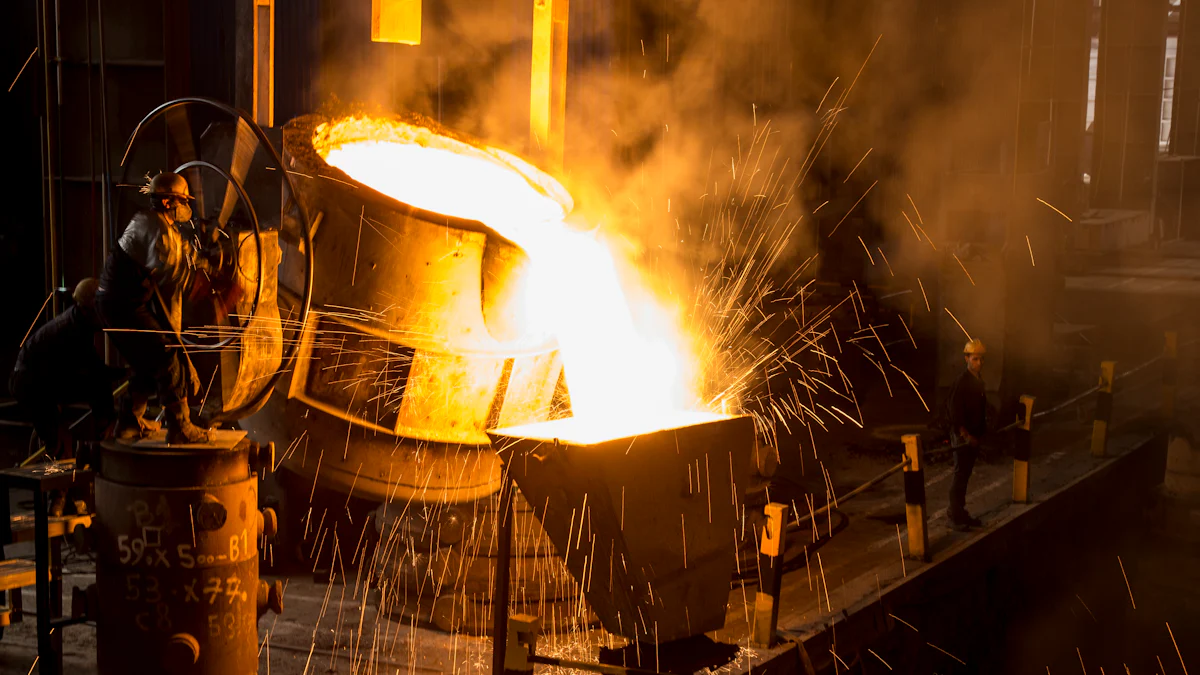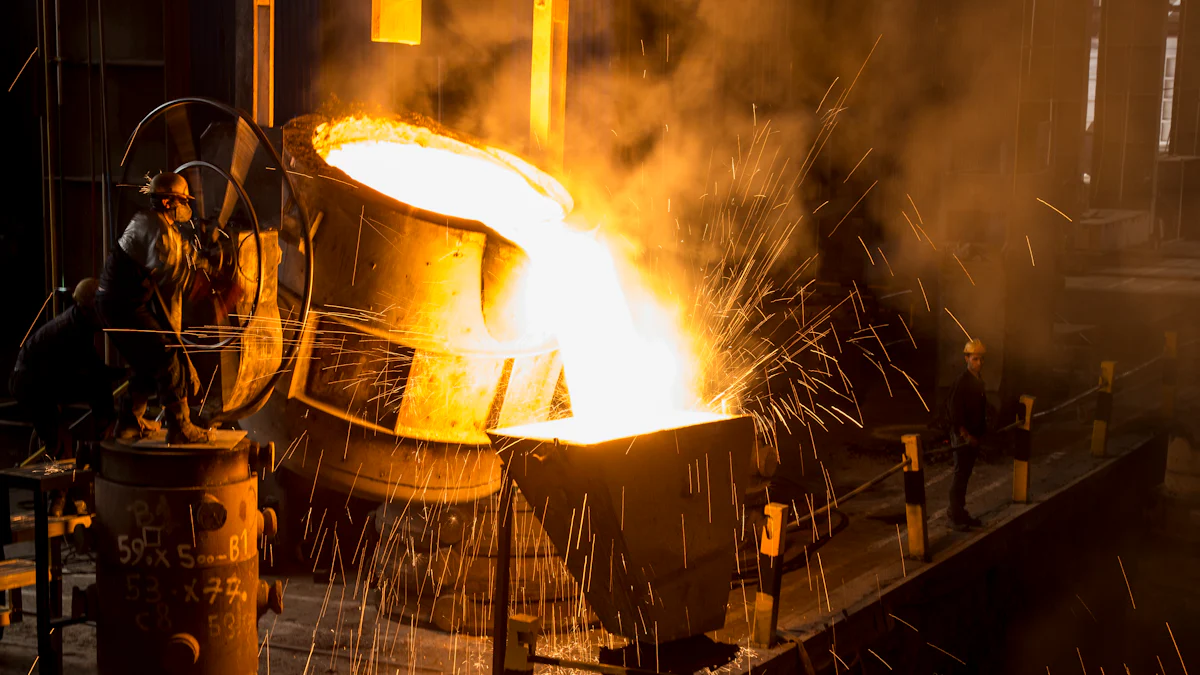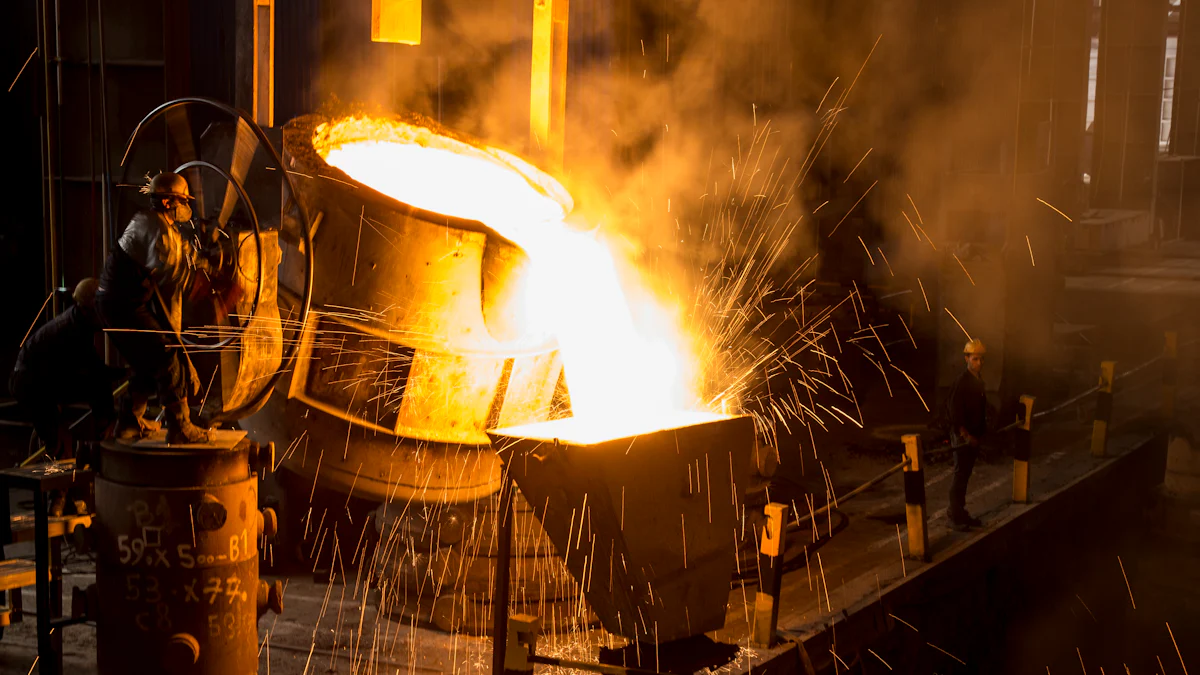Metal Melting Furnace Detailed Explanation
Metal Melting Furnace Detailed Explanation

Metal melting furnaces play a key role across industries, transforming solid metal into a liquid state for forming and casting. Efficiency is at the heart of this process, directly impacting energy consumption, emissions and overall productivity. This article aims to answer the question, “Which metal melting furnace is the most efficient?” By exploring the subtle differences and operational complexities of different types of furnaces, this article provides readers with valuable insights into optimizing the melting process.
Types of Metal Melting Furnaces

Induction Furnaces
Induction furnaces utilize electromagnetic induction to heat and melt metals efficiently. Consisting of a crucible and an induction coil generating a high-frequency electromagnetic field, they are suitable for a wide range of metals. Commonly found in foundries and metal processing plants, Induction Furnaces are known for their versatility and effectiveness.
Working Principle
- The induction furnace operates by inducing eddy currents within the metal through electromagnetic fields.
- This process causes the material to heat up rapidly, leading to efficient melting without direct contact with a heating element.
Advantages
- Induction Furnaces offer precise temperature control, ensuring uniform heating throughout the metal.
- They have high energy efficiency, minimizing heat loss during the melting process.
- These furnaces can melt various metals like iron, steel, copper, and aluminum with ease.
Disadvantages
- One drawback of Induction Furnaces is the initial investment cost, which can be higher compared to other furnace types.
- Maintenance and repair of complex components may require specialized knowledge and skills.
Core-Type Channel Furnaces
Core-Type Channel furnaces are considered the most efficient type of induction furnace due to their iron core concentrating magnetic flux in the molten loop, ensuring maximum power transfer from primary to secondary.
Electric Arc Furnaces
Electric Arc Furnaces use electric arcs to heat and melt metals efficiently. With components like a refractory-lined vessel, electrodes, and an electric power supply, these furnaces are commonly employed in steel mills and scrap metal processing facilities.
Working Principle
- The Electric Arc Furnace melts materials directly through contact with arcing electricity passing through them.
- This method allows for precise control over the melting process while maintaining high efficiency.
Advantages
- Electric Arc Furnaces excel in recycling scrap metal due to their ability to quickly melt various materials.
- They contribute to sustainable practices by reducing waste through effective recycling processes.
Disadvantages
- One limitation of Electric Arc Furnaces is that they may produce emissions during operation that need proper management.
- The size of these furnaces can sometimes limit their application in smaller-scale operations.
Crucible Furnaces
Working Principle
- Crucible furnaces and pot melting furnaces are designed for melting and holding various metals like zinc alloys, aluminum, copper, and bronze.
- These furnaces utilize a refractory crucible to contain the molten metal during the heating process.
- The heat source, typically from electricity or gas, is applied to the crucible directly, ensuring efficient and controlled melting of the metal.
Advantages
- Crucible Furnaces offer flexibility in melting different types of metals, making them versatile for various industrial applications.
- They provide precise temperature control, allowing for accurate heating of the metal to specific melting points.
- Optional features such as automated cover removal systems enhance operational efficiency by streamlining the melting process.
Disadvantages
- One limitation of Crucible Furnaces is their relatively smaller capacity compared to other furnace types, which may restrict large-scale production needs.
- Maintenance of the refractory lining within the crucible can be labor-intensive and require periodic replacement to ensure optimal performance.
- Metal leak detection circuits in some models add complexity to maintenance procedures and may necessitate specialized training for troubleshooting.
Factors Affecting Furnace Efficiency
Energy Consumption
Importance of energy efficiency
Efficiency in energy consumption is paramount in the operation of metal melting furnaces. Striving for optimal energy utilization ensures cost-effectiveness and environmental sustainability. By minimizing wastage and maximizing output, industries can enhance their competitive edge.
Methods to reduce energy consumption
Implementing innovative technologies and best practices can significantly reduce energy consumption in metal melting processes. Utilizing advanced insulation materials, optimizing heating cycles, and integrating automated controls are effective strategies. These methods not only enhance efficiency but also prolong the lifespan of furnace components.
StrikoMelter PUREFFICIENCY°
StrikoMelter PUREFFICIENCY°, recognized as a pinnacle of energy-efficient furnace equipment, sets a new standard in the industry. With its cutting-edge design and engineering, this furnace boasts the lowest energy consumption at 489 kWh/t. Investing in such advanced technology can revolutionize metal melting operations, leading to unparalleled efficiency gains.
Material Compatibility
Types of metals and their melting points
Understanding the properties of different metals is crucial for selecting the appropriate furnace type. Variations in melting points across metals necessitate tailored heating processes to achieve optimal results. From aluminum with a melting point of 660°C to copper at 1,085°C, each metal demands specific handling for efficient melting.
Furnace compatibility with different metals
Furnace selection plays a pivotal role in ensuring compatibility with various metals. Choosing the right furnace design that aligns with the melting characteristics of specific metals enhances operational efficiency. Whether it’s aluminum alloys or brass compositions, having a furnace that caters to diverse material requirements is essential for seamless production processes.
Operational Costs
Initial investment vs. long-term savings
Balancing initial investment costs with long-term savings is a critical consideration for businesses utilizing metal melting furnaces. Strategic financial planning that evaluates both immediate expenditures and future benefits is key to sustainable operations. While high-quality furnaces may require a substantial upfront investment, their efficiency and durability often lead to significant cost savings over time.
Maintenance and repair costs
Regular maintenance is imperative for preserving the efficiency and functionality of metal melting furnaces. Proactive upkeep measures, such as routine inspections and timely repairs, prevent costly breakdowns and downtime. Allocating resources towards preventive maintenance not only extends the lifespan of equipment but also minimizes overall operational expenses.
Innovations in Metal Melting Technology

Advanced Control Systems
In the realm of metal melting technology, advanced control systems have revolutionized operational efficiency and precision. By integrating automation and monitoring features, these systems optimize the melting process to unprecedented levels.
Automation and Monitoring
- Automation streamlines furnace operations by regulating heating cycles and material flow, enhancing overall productivity.
- Real-time monitoring ensures constant surveillance of temperature variations and energy consumption, enabling prompt adjustments for optimal performance.
Benefits of Advanced Control Systems
- Enhanced Efficiency: Advanced control systems minimize human error, leading to consistent and accurate melting results.
- Cost Savings: By optimizing energy usage and material handling, these systems reduce operational costs in the long run.
- Improved Safety: Automated safety protocols mitigate risks associated with manual intervention, ensuring a secure working environment.
Eco-friendly Technologies
The shift towards sustainability has spurred the development of eco-friendly technologies in metal melting furnaces. These innovations prioritize environmental responsibility without compromising on performance or output quality.
Reduction of Emissions
- Eco-friendly furnaces employ cutting-edge filtration systems to trap harmful emissions, promoting cleaner air quality.
- By minimizing carbon footprint through efficient combustion processes, these technologies contribute to a greener industrial landscape.
Sustainable Practices in Metal Melting
- Recycling initiatives within eco-friendly furnaces enable the reuse of scrap metals, reducing waste and conserving natural resources.
- Implementing sustainable cooling methods and energy-efficient designs further align metal melting practices with eco-conscious standards.
Hybrid Furnaces
The emergence of hybrid furnaces marks a significant advancement in metal melting technology, offering versatility and enhanced capabilities through innovative design concepts.
Combination of Different Furnace Types
- Hybrid furnaces integrate the strengths of various furnace types, such as induction and arc furnaces, to maximize efficiency and flexibility.
- By blending different heating mechanisms, these furnaces cater to diverse melting requirements across a wide range of metals.
Advantages of Hybrid Systems
- Optimized Performance: The synergy between multiple furnace technologies results in superior melting speed and precision.
- Adaptability: Hybrid systems can accommodate fluctuating production demands by adjusting heating methods accordingly.
- Versatility: With the ability to melt various metals effectively, hybrid furnaces offer a comprehensive solution for diverse industrial applications.
Mini-Melt Furnaces
Lightweight Design
- Shaft melting furnaces are renowned for their exceptional energy efficiency, setting them apart from conventional furnace types.
- The unique design principles of shaft furnaces contribute to their lightweight structure, enhancing portability and ease of installation.
- This feature enables seamless integration into diverse industrial settings, catering to the evolving needs of metalworking operations.
High Energy Efficiency
- Induction furnaces have established a reputation for superior energy efficiency compared to electric arc furnaces.
- By utilizing direct heating through electromagnetic induction, these furnaces minimize heat loss during the melting process.
- This innovative approach not only enhances operational efficiency but also reduces overall energy consumption, aligning with sustainable practices in metal melting.

